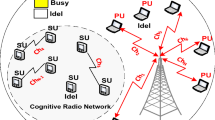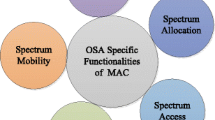Abstract
Spectrum sharing is one of the most important stages in cognitive radio wireless networks, responsible for the opportunistic allocation of free channels to unlicensed users (SUs) to be utilized in data transmission. One of the critical issues at this stage, is related to the absence of a module capable of allocating the available resources fairly to all network users. In this sense, the paper develops a media access control protocol (MAC) for cognitive networks based on infrastructure called CRUD-MAC, which allows to take advantage of channel access in a more equitable and efficient way; for this purpose two algorithms we designed within the MAC standard (using ANFIS and FAHP) for the ranking or classification of SUs by score when assigned channels based on network usage historical metrics, so that nodes with better ranking have priority in the allocation. Validation of the proposals was made by comparing the performance of CRUD-MAC with ANFIS, FAHP, and a channel assignment algorithm, not including ranking. The results show that the system is more efficient from the standpoint of fair allocation of resources.
























Similar content being viewed by others
References
Akyildiz, I. F., Lee, W.-Y., Vuran, M. C., & Mohanty, S. (2008). A survey on spectrum management in cognitive radio networks. IEEE Communications Magazine, 46(4), 40–48.
Mitola, I. I. I. J. (2001). Cognitive radio for flexible mobile multimedia communications. Mobile Networks and Applications, 6(5), 435–441.
Mitola, J., & Maguire, G. Q. (1991). Cognitive radio: making software radios more personal. IEEE Personal Communications, 6(4), 13–18.
Márquez, H. (2016). Modelo de asignación multicanal con criterio de equidad en redes de radio cognitiva. Master’s thesis, Faculty of Engineering, Distrital University, Bogotá, Colombia.
López, D., Rivas, E., & Gualdron, E. (2014). Proposed methodology for assignment of spectral bands in wireless cognitive radio networks. Journal Tecnura, 8(special edition doctorate), 61–69.
Lee, W. (2009). Spectrum management in cognitive radio wireless network. Ph.D. Thesis, School of Electrical and Computer Electrical, Georgia Institute of Technology, Georgia, USA.
Guillen, J. (2012). Algoritmo para acceso al medio en redes inalámbricas cognitivas. Master’s thesis, Autónoma Metropolitana University, City of México, México.
Chakraborty, J., Varma, J. V. K. C., & Erman, M. (2014). ANFIS based opportunistic power control for cognitive radio in spectrum sharing. In International conference on electrical information and communication technology (EICT) (pp. 1–6).
Miltra, D., & Mahapatra, R. D. (2013). FIS based cognitive radio scheduling. In IEEE international conference on fuzzy systems (FUZZ) (pp. 1–7).
Zhao, Y., Song, M., & Xin, C. (2013). FMAC: A fair MAC protocol for coexisting cognitive radio. In Proceedings IEEE INFOCOM (pp. 1474–1482).
Armi, N., Saad, N. M., Yussof, M. Z., & Arshad, M. (2010). MAC protocol for opportunistic spectrum access in cognitive radio networks. In IEEE symposium on industrial electronics and applications (ISIEA), Penang, Malaysia.
Le, L., & Ekram, H. (2007). QoS-Aware spectrum sharing in cognitive wireless networks. In IEEE global telecommunications conference (GLOBECOM’07) (pp. 3563–3567).
Le, Y., Ma, L., Cheng, W., Cheng, X., & Chen, B. (2013). A time fairness-based MAC algorithm for throughput maximization in 802.11 networks. IEEE Transactions on Computers, 64(1), 19–31.
Tan, X., Yin, C., & Ma, L. (2014). Positional proportional fairness scheduling based on spectrum aggregation in cognitive radio. In International conference on telecommunications (ICT) (pp. 176–180).
Huang, P., Wang, C., & Xiao, L. (2015). RC-MAC: A receiver-centric MAC protocol for event-driven wireless sensor networks. IEEE Transactions on Computers, 64(4), 1149–1161.
Chen, L., Iellamo, S., Coupechoux, M., & Godlewski, P. (2011). Spectrum auction with interference constraint for cognitive radio networks with multiple primary and secondary users. Journal Wireless Networks, 17(5), 1355–1371.
Wang, L.-C., Wang, C.-W., & Adachi, F. (2011). Load-balancing spectrum decision for cognitive radio networks. IEEE Journal on Selected Areas in Communications, 29(11), 757–769.
Liu, Y., & Knightly, E. (2003). Opportunistic fair scheduling over multiple wireless channels. In Twenty-second annual joint conference of the IEEE computer and communications (pp. 1106–1115).
Yang, Z., Yao Y.-D., Chen, S., He, H., & Zheng, D. (2010). MAC protocol classification in a cognitive radio network. In 19th Annual wireless and optical communications conference (pp. 1–5).
Wang, V. (2015). Handbook of research on learning outcomes and opportunities in the digital age (pp. 510–537). Hershey: IGI Global.
Wyglinski, A., Nekovee, M., & Hou, T. (2010). Cognitive radio communications and network: Principles and practice (pp. 201–231). Amsterdam: Elsevier.
Li, S., Ekici, E., & Shroff, N. (2015). Throughput-optimal queue length based CSMA/CA algorithm for cognitive radio networks. IEEE Transaction on Mobile Computing, 14(5), 1098–1108.
Su, H., & Zhang, Z. (2008). Cross-layer based opportunistic MAC protocols for QoS provisionings over cognitive radio networks. IEEE Journal on Selected Areas in Communications, 26(1), 118–129.
Atayero, A., & Sheluhin, O. (2013). Integrated models for information communication systems and networks: Design and development (pp. 343–358). Hershey: IGI Global.
He, A., Bae, K., Newman, T., Gaeddert, J., Kim, K., Menon, R., et al. (2010). A survey artificial intelligence for cognitive radios. IEEE Transactions on Vehicular Technology, 59(4), 1578–1592.
Roger, J.-S. (1993). ANFIS: Adaptative-network-based fuzzy inference system. IEEE Transactions on Systems, Man and Cybernetics, 23(3), 665–685.
Adeli, H., & Siddique, N. (2013). Computational intelligence: Synergies of fuzzy logic, neural networks and evolutionary computing (pp. 357–409). London: Wiley.
Keller, J., & Fogel, D. (2016). Fundamentals of computational intelligence: Neural networks, fuzzy systems, and evolutionary computation (pp. 77–191). London: Wiley.
Samui, P. (2016). Handbook of research on advanced computational techniques for simulation-based engineering (pp. 171–194). Hershey: IGI Global.
Jang, J.-S., Sun, C.-T., & Mizutani, E. (1997). Neuro-fuzzy and soft computing: A computational approach to learning and machine intelligence (pp. 173–194). Englewood Cliffs: Prentice Hall.
Mehbodniya, A., Kaleem, F., Yen, K., & Adachi, F. (2012). A fuzzy MADM ranking approach for vertical mobility in next generation hybrid networks. In 4th International congress on ultra modern telecommunications and control systems and workshops (ICUMT) (pp. 262–267).
Chang, D.-Y. (1996). Applications of the extent analysis method on fuzzy AHP. European Journal of Operational Research, 95(3), 649–655.
Büyüközkan, G., Kahraman, C., & Ruan, D. (2004). A fuzzy multicriteria decision approach for software development strategy selection. International Journal of General Systems, 33(2–3), 259–280.
Miranda, E. (2001). Improve subjective estimates using paired comparison. Journal IEEE Software, 18(1), 87–91.
López, D., Ordoñez, J., & Rivas, E. (2016). User characterization through dynamic Bayesian networks in cognitive radio wireless networks. International Journal of Engineering and Technology, 8(4), 1771–1783.
Palangi, H., Deng, L., Sheng, Y., Gao, J., He, X., Chen, J., et al. (2016). Deep sentence embedding using long short-term memory networks: Analysis and application to information retrieval. IEEE/ACM Transactions on Audio, Speech, and Language Processing, 24(4), 694–707.
Rahnema, M. (1993). Overview of the GSM system and protocol architecture. IEEE Communications Magazine, 31(4), 92–100.
Ning, G., Cao, X., Duan, J., & Chowdhury, K. (2011). A spectrum sharing algorithm based on spectrum heterogeneity for centralized cognitive radio networks. In 73rd Vehicular technology conference (VTC Spring) (pp. 1–5).
Gavrilovska, L., Denkovski, D., Rakovic, V., & Angjelichinoski, M. (2014). Medium access control protocol in cognitive radio networks: Overview and general classification. IEEE Communications Survey and Tutorials, 16(4), 2092–2124.
Nobar, S., Mehr, K., & Niya, J. (2015). Comprehensive performance analysis of IEEE 802.15.17 CSMA mechanism for saturated traffic. Journal of Optical Communications and Networking, 7(2), 62–73.
Hernández, J., Rodríguez, E., Marcelín, R., & Pascoe, M. (2012). CRUAM-MAC: A novel cognitive radio MAC protocol for dynamic spectrum Access. In IEEE Latin-America conference on communications (LATINCOM) (pp. 1–6).
Mathworks, Matlab. (2014). Fuzzy logic toolbox. http://www.mathworks.com/.
Jain, R., Chiu, D.-M., & Hawe, W. (1984). A quantitative measure of fairness and discrimination for resource allocation and shared computer system. (September). http://www.cs.wustl.edu/~jain/papers/ftp/fairness.pdf.
Author information
Authors and Affiliations
Corresponding author
Rights and permissions
About this article
Cite this article
López, D.A., Rojas, C.A., Zapata, D.F. et al. Designing a MAC Algorithm for Equitable Spectrum Allocation in Cognitive Radio Wireless Networks. Wireless Pers Commun 98, 363–394 (2018). https://doi.org/10.1007/s11277-017-4873-0
Published:
Issue Date:
DOI: https://doi.org/10.1007/s11277-017-4873-0




